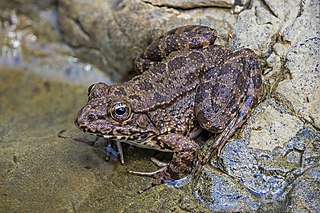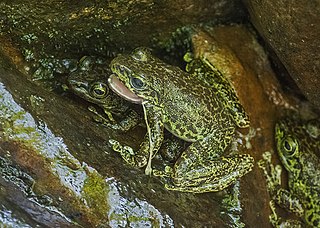
Arunachal Pradesh is a state in northeast India. It was formed from the North-East Frontier Agency (NEFA) region, and India declared it as a state on 20 February 1987. Itanagar is its capital and largest town. It borders the Indian states of Assam and Nagaland to the south. It shares international borders with Bhutan in the west, Myanmar in the east, and a disputed 1,129 km border with China's Tibet Autonomous Region in the north at the McMahon Line. It is disputed by China and claimed as part of Tibet. China occupied some regions of Arunachal Pradesh in 1962 but later withdrew its forces.

True frogs is the common name for the frog family Ranidae. They have the widest distribution of any frog family. They are abundant throughout most of the world, occurring on all continents except Antarctica. The true frogs are present in North America, northern South America, Europe, Africa, and Asia. The Asian range extends across the East Indies to New Guinea and a single species, the Australian wood frog, has spread into the far north of Australia.

The Namdapha flying squirrel is an arboreal, nocturnal flying squirrel endemic to Arunachal Pradesh in northeast India, where it is known from a single specimen collected in Namdapha National Park in 1981. No population estimate is available for B. biswasi, but the known habitat is tall Mesua ferrea jungles, often on hill slopes in the catchment area of Dihing River in northeastern India.

Namdapha National Park is a 1,985 km2 (766 sq mi) large protected area in Arunachal Pradesh of Northeast India. The park was established in 1983. With more than 1,000 floral and about 1,400 faunal species, it is a biodiversity hotspot in the Eastern Himalayas. The national park harbours the northernmost lowland evergreen rainforests in the world at 27°N latitude. It also harbours extensive dipterocarp forests, comprising the northwestern parts of the Mizoram-Manipur-Kachin rain forests ecoregion.

Amolops formosus, also known as Assam sucker frog, beautiful stream frog, Assam cascade frog, or hill stream frog, is a species of frog found in high gradient streams of northern India, northern Bangladesh, and Nepal, possibly also Bhutan, although these records may represent confusion between Amolops himalayanus and this species; the latest available IUCN assessment from 2004 treats A. himalayanus as a synonym of A. formosus.

Mystus is a genus of fish in the family Bagridae native to Asia. Phylogenetic relationships within this genus are poorly understood, though it has been suggested that there are two major lineages.
Amolops medogensis is a species of frog in the family Ranidae, the "true frogs". It is endemic to Mêdog County in southeastern Tibet. Its range might extend into the adjacent Arunachal Pradesh, India. Common name Medog torrent frog has been proposed for it.

Nidirana adenopleura is a species of frog in the family Ranidae. It is found in Taiwan, south-eastern China, and in the Yaeyama Islands. Populations from Yaeyama Islands might represent a distinct, as yet undescribed species. The records from Vietnam and Thailand are uncertain.

Odorrana chloronota, commonly known as the chloronate huia frog or copper-cheeked frog, is a species of frog in the family Ranidae that is found in Cambodia, China, India, Laos, Myanmar, Thailand, Vietnam, and possibly Bangladesh and Nepal.
The Emei music frog is a species of frog in the family Ranidae. It is endemic to China, and is found in central China, in southeastern Sichuan, northeastern Yunnan and western Guizhou provinces. The species name refers to the type locality, Mount Emei in Sichuan, and its vocalizing abilities. The original name Rana musica was replaced with Rana daunchina as the former name was already taken.
The Yunnan pond frog is a species of frog in the family Ranidae found in south-western China and possibly in adjacent parts of Myanmar. The total length of this medium-sized frog is 54–56 mm (2.1–2.2 in).

Pseudophilautus variabilis, also known as the variable bush frog or variable bubble-nest frog, is a species of frog in the family Rhacophoridae. This now extinct species was endemic to Sri Lanka. Despite extensive searches in recent times, it is only known from collections prior to 1858. The reasons for its disappearance are unknown but probably involve habitat loss.

The bar-winged wren-babbler is a species of bird in the family Timaliidae. It is found in Bhutan, China, India, and Myanmar. Its natural habitat is subtropical or tropical moist montane forest.

Hylarana, commonly known as golden-backed frogs, is a genus of true frogs found in tropical Asia. It was formerly considered highly diverse, containing around 84 to 96 valid species, but taxonomic revision resulted in a major change in the contents of the genus, and today it is recognised as containing just four species.
Nidirana chapaensis, commonly known as the Chapa frog or glandular-sided frog, is a species of frog in the family Ranidae. It is found in Laos, Vietnam, and Thailand, although records from Thailand may refer to Nidirana lini.
Raorchestes sahai, sometimes known as the Sahai bushfrog or Sahai bush frog, is a frog found by the Noa Dihing river near Gandhigram in Changlang district, Arunachal Pradesh, India.

Arunachal Pradesh is primarily a hilly tract nestled in the foothills of the Himalayas in northeast India. It is spread over an area of 83,743 km2 (32,333 sq mi). 98% of the geographical area is land out of which 80% is forest cover; 2% is water. River systems in the region, including those from the higher Himalayas and Patkoi and Arakan Ranges, eventually drain into the Brahmaputra River.
Nanorana arunachalensis is a species of frog in the family Ranidae that is found in streams of Lower Subansiri district, Arunachal Pradesh, India. The presence of black mark between this frog's eyes separate it from other frog species in this genus.
Aborichthys waikhomi is a species of stone loach found in the Noa-Dihing River, upper Brahmaputra basin in the Namdapha National Park and Tiger Reserve in Arunachal Pradesh, India. This fish grows to a length of 6.8 centimetres (2.7 in) SL.

Nidirana is a genus of true frogs (Ranidae) from East and Southeast Asia. They are commonly known as music frogs. This genus contains numerous species that were formerly classified in the genus Babina, which is thought to be its sister genus.












